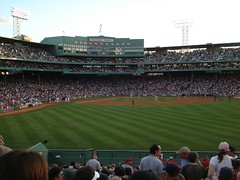 Both the Boston Red Sox and sleep apnea were both mentioned in the same article by Gary Gillis on the Official Boston Red Sox website on MLB.com here.
Both the Boston Red Sox and sleep apnea were both mentioned in the same article by Gary Gillis on the Official Boston Red Sox website on MLB.com here.Gillis writes about how traveling around the world to play exhibition games in Japan put a strain on Red Sox players' sleep patterns. He goes on to talk about sleeping patterns and how Americans are often sleep deprived.
Then he talks about sleep disorders, mentioning sleep apnea: "Caused by soft tissue blocking the airway, apnea more often affects men than women. It can lead to hypertension and increase the risk of stroke." Not mentioned are the many other risks of untreated sleep apnea including heart disease, high blood pressure and, of course, sleep disruption. Sleep disruption causes daytime sleepiness - preventing Red Sox fans from staying awake for the game!
A doctor interviewed in the article says that most disorders are treatable and can return a patient back to a normal night's sleep. Here on Sleep Apnea Guide, sleep apnea treatments are often discussed. Sleep apnea is highly treatable and there are several options.
The most common treatment is the use of a CPAP machine (a small device that pushes air down a patient's airway passage through a mask), but I've mentioned a few promising alternative treatments and sleep apnea studies on Sleep Apnea Guide. I've been using a CPAP machine for years. It's not as bad as it sounds, but it takes some time to adjust to it.
I am more awake with treatment and ready for the Boston Red Sox to win the World Series again and again.
